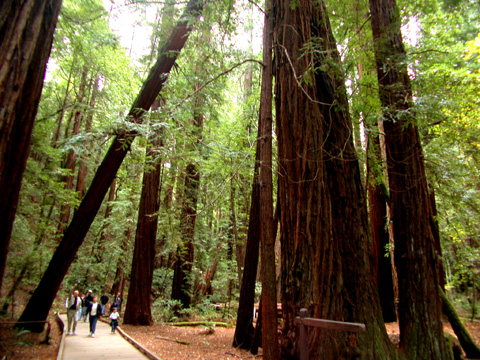A long time friend from weblogging, Allan Moult, has restarted his weblog. Welcome back, Allan, you’ve been missed. I look forward to many of your photographs with that digital camera you have and that I covet so strongly.
A catalyst for Allan’s return is effort he’s involved in with regards to Tasmania’s environmental treasures, specifically the Styx Valley. As part of this effort, there’s a campaign afoot to build an enclosure within the forest, completely made out of red knitted panels. The hope is to use this effort to demonstrate international support for the local group’s efforts to protect trees that are the largest in the world – second only to California’s Redwood forests. What are these grand old trees used for?
Wood chips. For Japan. For processing.
The town I grew up in, Kettle Falls, originally was an old timber town. I remember the wood mill just outside of town, and looking at it’s rusty brown slanted walls, and watching the fire and the smoke and the sparks come out of the top as the by-product of the timber refinement was burnt off. I also remember summer days when the wind was just right, trying to ride a bike or play ball when the smoke was so thick, you could barely see and it made your eyes water. And the smell. All the time, the smell.
In later years, when I started hiking I would travel to the mountains of the Northwest and I remember driving long highways with trees thick as night along side of the road. However, if you once pulled off on old timber trucking roads, you would find clear cut as far as the eye can see, hidden behind the trees so that the timber companies and the government could hide exactly how much public land was being cut down to stumps and weeds.
I remember my grandfather talking about the timber industry. He was a farmer but had to supplement his income with a job in the local timber mill, as most folks did in that area. Thanks to progress, and machines that enable one person to do the job of 100, the number of jobs the timber industry generates is pitiful; to continue to use this as a reason for timbering what should be publicly held lands, held for future generations, is a sham. My grandfather once said that the timber industry was …a crime against the people and against the land….
I’ve also looked, with approval, at efforts in Washington and elsewhere to create tree farms using trees that make the most use of a little bit of land and that are perfect for wood pulp and wood chips and other products we need. Row after row of tightly packed trees in a couple of acres meant several hundred acres of natural forest would be left untouched. There are alternatives, but they’re not as profitable.
There’s no need for old growth forest to be touched, other than a robber baron mentality that says grab while the grabbing’s good. And while the public is watching their televisions at night, their sitcoms and their unbiased news, their reality shows and their public programs and their sports and movies, rape their heritage and fade away in the night, pockets full of dimes.
There is no trade deficit, no employment program, and no tax-base that is overly influenced by timber to the point that giving up our remaining tiny spots of old growth forests is a fair trade.
I don’t knit and my only attempt was a purple and gold scarf for my brother that ended all curly and so tight you could use it for a pot holder. You would wrap it around your neck only if you were interested in dermabrasion therapy. But I can write, so I write in support of Allan’s efforts and encourage those of you that do knit, to think about buying a bit of red yarn and helping our friends down under preserve a tiny bit of their legacy.
And welcome back again, Allan. Give ‘em hell, have an amber for me – and post some pics, will you?

